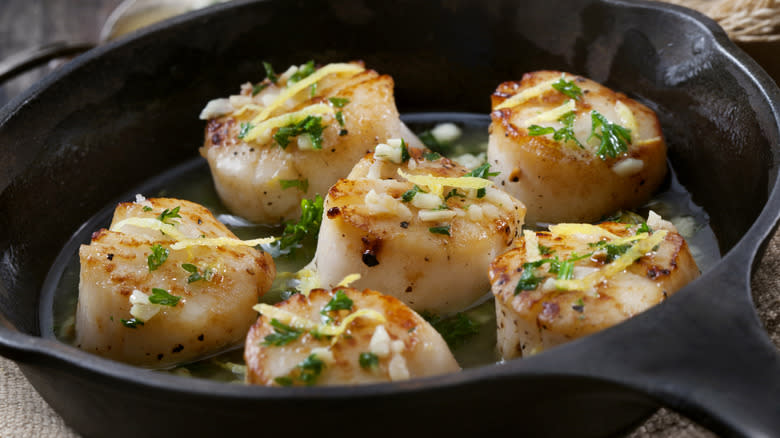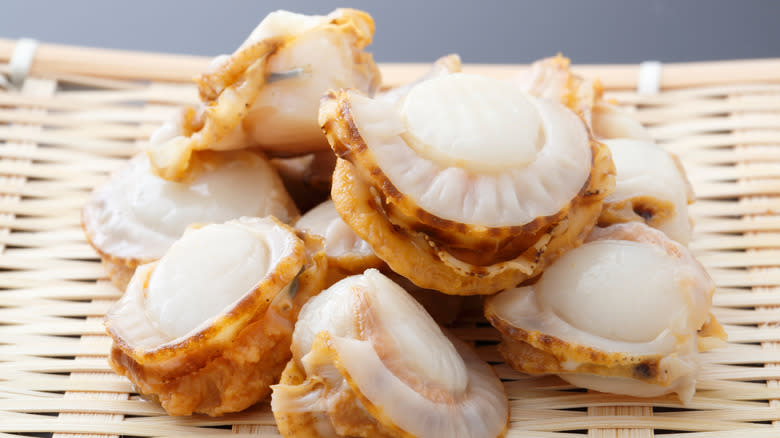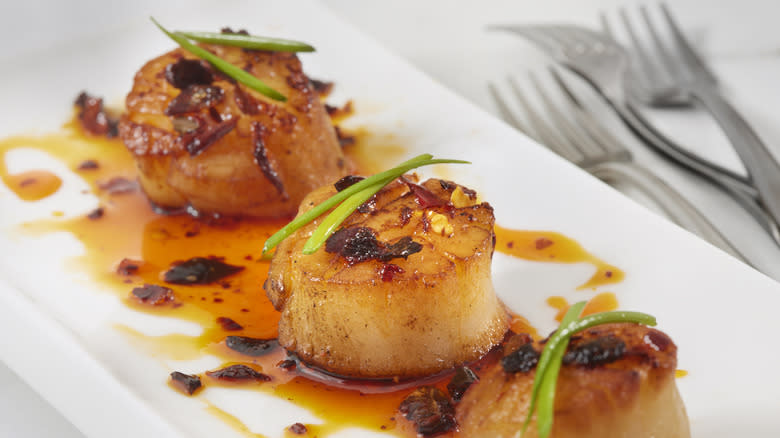Scallops Are Pricey, Here's The Top Tip You Need For Buying The Right Amount

Whether pan-seared and sautéd or tossed in a gumbo, scallops are a delicious if pricey seafood delicacy. So, it's important to know how many to buy if you serve scallops at a dinner party or for your family. Cooked scallops only last three or four days in the fridge, according to the USDA, and taste better freshly cooked anyway. The last thing you want is to overspend only to feed the garbage bin.
The first thing you should know is that two types of scallops are sold commonly: sea and bay scallops. Sea scallops are generally larger, ranging from 1 ½ to 2 inches across. Comparatively, bay scallops are only about ½ inch in diameter. You will get around 20 to 30 sea scallops in a pound compared to 50 to 100 bay scallops.
If you're buying larger sea scallops, plan to buy three or four per person. You can scale this appropriately if you're dealing with smaller scallops, so if you're buying bay scallops, plan to purchase 12 to 16 of them. For a dinner for two, buy about ⅓ pound of scallops, whatever their size. Likewise, 1 pound of scallops, whether sea or bay scallops, will serve a dinner for six.
Read more: 13 Tips To Make Your Shrimp Taste So Much Better
What To Look For When Buying Scallops

Besides the amount, there are other factors to consider when buying scallops. For one, you should be wary of discoloration, a sign that the seafood's packaging may have a broken seal. Oxygen causes scallops to discolor and quickly deteriorate. The smell is a dead giveaway that scallops may be past their best. While seafood naturally has a slight fishy smell, it's likely your scallops are bad if they have a particularly strong odor. Likewise, scallops are sold both fresh and frozen. If frozen, and they have ice crystals in them, then they probably have freezer burn.
Sea scallops are more common since they are typically farm-raised, whereas bay scallops are found in harbors on the East Coast and other areas. If you're planning on sautéing your scallops, then consider purchasing sea scallops, as their larger surface area makes for a better sizzle. Bay scallops are typically served in stews and gumbos.
Besides the variety of scallops you buy, you should also consider the difference between wet-packed and dry-packed scallops. Wet-packed scallops have been treated with additives in brine to extend their shelf life. Meanwhile, dry-packed scallops are untreated, which many prefer. The issue with wet-packed scallops is that the brine can affect their taste and make them harder to cook.
Why Scallops Are So Expensive

Scallops are typically sold by the pound, which means you're paying a market price per pound. Of course, some grocery stores sell them prepackaged or frozen, but for the best quality, go to a fish market. The number of scallops you get per pound varies and is distinguished by a number preceded by the letter U. For instance, if you have 20 scallops per pound, it's represented by U20.
As they say, you get what you pay for, and the price of scallops varies based on how they're harvested. Diver scallops are considered the rarest and, therefore, the most expensive on the market because they're harvested manually from the ocean floor, which ensures a superior product. Less than 1% of all scallops harvested are classed as diver scallops, making them sought after for their quality.
Meanwhile, most sea scallops sold in the United States are farm-raised, meaning they are cultivated on farms. If you're looking for wild scallops, look for the term wild-caught when purchasing scallops. According to CBS News, a dwindling supply of scallops has caused the prices to rise over the past few years, from $20 to $25 per pound on average. The number of scallops harvested decreased from 60 million pounds in 2019 to an estimated 34 million in 2022, explaining the price increase. Experts suggest declining numbers are due to a "natural cycle."
Read the original article on Daily Meal.

